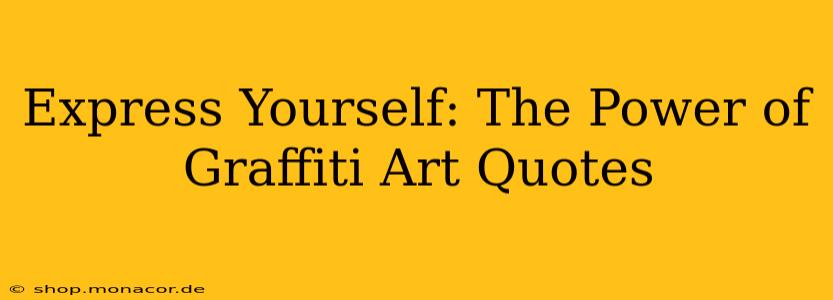Graffiti art, often perceived as vandalism, is a powerful form of visual expression. Beyond the illegality and controversy, it's a vibrant tapestry woven with social commentary, personal narratives, and breathtaking artistry. One key element that amplifies this impact is the use of quotes. These carefully chosen words, sprayed onto walls and buildings, transform simple images into thought-provoking statements. This article delves into the power of graffiti art quotes, exploring their impact on viewers and the artists who create them.
Why Do Graffiti Artists Use Quotes?
Graffiti artists frequently incorporate quotes for several reasons:
-
To amplify a message: A visually striking image paired with a potent quote creates a synergistic effect, enhancing the overall impact and ensuring the message resonates deeply. The quote provides context and layers meaning onto the artwork, going beyond the purely visual.
-
To pay homage: Quotes can serve as tributes to influential figures, movements, or philosophies that inspire the artist. This act of homage adds another dimension to the artwork, connecting it to a larger cultural context.
-
To provoke thought: A well-chosen quote challenges viewers to reflect on the message conveyed, sparking dialogue and debate. This interactive element elevates graffiti from mere decoration to a catalyst for social interaction.
-
To express personal feelings: For some artists, quotes are a direct window into their innermost thoughts and emotions. They offer a personal and intimate connection with the viewer, making the art feel relatable and human.
What Makes a Powerful Graffiti Art Quote?
The effectiveness of a graffiti art quote hinges on several factors:
-
Brevity and impact: Short, memorable quotes often have the most potent effect. They're easy to read and retain, allowing the message to stick with the viewer.
-
Relevance and context: The quote needs to be relevant to the image and the artist's overall message. It should enhance, not detract from, the visual impact.
-
Visual appeal: The font, size, and placement of the quote are crucial. The typography should complement the artwork's style and enhance its readability.
-
Emotional resonance: Powerful quotes evoke strong emotions in the viewer. They tap into shared experiences and resonate on a deeper level.
What are some famous examples of graffiti art quotes?
While many graffiti artists' works remain anonymous, some famous examples showcase the power of the quote:
-
Banksy's works: Banksy, a world-renowned street artist, frequently employs poignant quotes in his satirical pieces, often challenging social norms and political systems. His work isn't always easily accessible due to its ephemeral nature and the artist's anonymity, but his impact is undeniable.
-
Shepard Fairey's "Obey Giant" campaign: Although not strictly graffiti, Fairey’s campaign utilized powerful imagery paired with stark text, heavily influencing modern street art. The simple yet provocative nature of the design and quotes made it instantly recognizable.
-
Various independent artists: Countless independent artists worldwide leverage quotes to express their unique perspectives. Exploring online galleries and street art communities offers insights into the variety of styles and messages.
How does the location of graffiti art impact the power of the quote?
The location itself adds a layer of context to the graffiti art and the quote. A quote about social injustice sprayed on a government building carries a significantly different weight than the same quote painted on a brick wall in a secluded alley. The setting creates a dialogue between the message and the environment, reinforcing or even contradicting the quote's meaning.
What are some common themes explored in graffiti art quotes?
Graffiti artists often explore a wide range of themes, including but not limited to:
-
Social and political activism: Quotes advocating for social justice, equality, and freedom of expression are commonplace.
-
Personal struggles and triumphs: Artists might use quotes to express their personal battles with addiction, mental health, or societal pressure.
-
Environmental awareness: Quotes highlighting the importance of environmental protection and sustainability are increasingly prevalent.
-
Love, loss, and relationships: Graffiti can also be a canvas for expressing the complexities of human relationships.
Conclusion
Graffiti art quotes are more than just words painted on a wall; they are powerful tools of communication, social commentary, and personal expression. By understanding the artistic choices behind the quote—its selection, placement, and visual presentation—we gain a deeper appreciation for the message and the artist's intention. The fusion of visual art and compelling words creates a synergy that transforms public spaces and encourages reflection on important issues. The continued evolution of this art form assures that its message and its power will resonate for years to come.

